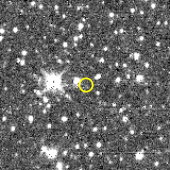 Sinope photographed by the Haute-Provence Observatory on 14 August 1998 Sinope photographed by the Haute-Provence Observatory on 14 August 1998 | |
| Discovery | |
|---|---|
| Discovered by | Seth B. Nicholson |
| Discovery site | Lick Observatory |
| Discovery date | 21 July 1914 |
| Designations | |
| Designation | Jupiter IX |
| Pronunciation | /səˈnoʊpiː/ |
| Named after | Σινώπη Sinōpē |
| Adjectives | Sinopean /saɪnəˈpiːən/ |
| Orbital characteristics | |
| Epoch 23 March 2018 (JD 2458200.5) | |
| Observation arc | 103.87 yr (37,938 days) |
| Semi-major axis | 0.1629144 AU (24,371,650 km) |
| Eccentricity | 0.3366550 |
| Orbital period (sidereal) | –777.29 d (2.13 years) |
| Mean anomaly | 71.53524° |
| Mean motion | 0° 27 47.33 / day |
| Inclination | 158.63840° (to ecliptic) |
| Longitude of ascending node | 8.61437° |
| Argument of perihelion | 60.30205° |
| Satellite of | Jupiter |
| Group | Pasiphae group |
| Physical characteristics | |
| Mean diameter | 35.0±0.6 km |
| Synodic rotation period | 13.16±0.10 h |
| Albedo | 0.042±0.006 |
| Apparent magnitude | 18.3 |
| Absolute magnitude (H) | 11.1 |
Sinope /səˈnoʊpiː/ is a retrograde irregular satellite of Jupiter discovered by Seth Barnes Nicholson at Lick Observatory in 1914, and is named after Sinope of Greek mythology.
Sinope did not receive its present name until 1975; before then, it was simply known as Jupiter IX. It was sometimes called "Hades" between 1955 and 1975.
Orbit

Sinope orbits Jupiter on a high-eccentricity and high-inclination retrograde orbit. Its orbit is continuously changing due to solar and planetary perturbations. Sinope is believed to belong to the Pasiphae group of retrograde irregular moons. However, given its mean inclination and different colour, Sinope could be also an independent object, captured independently, unrelated to the collision and break-up at the origin of the group. The diagram illustrates Sinope's orbital elements in relation to other satellites of the group.
Sinope is also known to be in a secular resonance with Jupiter, similar to Pasiphae. However, Sinope can drop out of this resonance and has periods of both resonant and non-resonant behaviour in time scales of 10 years.
Physical characteristics

From measurements of its thermal emission, Sinope has an estimated diameter of 35 km (22 mi). Sinope is red (colour indices B−V=0.84, R−V=0.46), unlike Pasiphae, which is grey.
Sinope's infrared spectrum is similar to those of D-type asteroids but different from that of Pasiphae. These dissimilarities of the physical parameters suggest a different origin from the core members of the group.
See also
References
- ^ Nicholson, S. B. (1914). "Discovery of the Ninth Satellite of Jupiter". Publications of the Astronomical Society of the Pacific. 26 (1): 197–198. Bibcode:1914PASP...26..197N. doi:10.1086/122336. PMC 1090718. PMID 16586574.
- "Sinope". Dictionary.com Unabridged (Online). n.d.
- Noah Webster (1884) A Practical Dictionary of the English Language
- Sergey Vnukov (2010) "Sinopean Amphorae of the Roman Period", Ancient Civilizations from Scythia to Siberia 16
- Hector Stuart (1876) Ben Nebo, and Other Poems, p. 22
- ^ "M.P.C. 111777" (PDF). Minor Planet Circular. Minor Planet Center. 25 September 2018.
- ^ Grav, T.; Bauer, J. M.; Mainzer, A. K.; Masiero, J. R.; Nugent, C. R.; Cutri, R. M.; et al. (August 2015). "NEOWISE: Observations of the Irregular Satellites of Jupiter and Saturn". The Astrophysical Journal. 809 (1): 9. arXiv:1505.07820. Bibcode:2015ApJ...809....3G. doi:10.1088/0004-637X/809/1/3. S2CID 5834661. 3.
- Luu, Jane (September 1991). "CCD photometry and spectroscopy of the outer Jovian satellites". Astronomical Journal. 102: 1213–1225. Bibcode:1991AJ....102.1213L. doi:10.1086/115949. ISSN 0004-6256.
- Sheppard, Scott. "Scott S. Sheppard - Jupiter Moons". Department of Terrestrial Magnetism. Carnegie Institution for Science. Retrieved 26 November 2020.
- Nicholson, S. B. (April 1939). "The Satellites of Jupiter". Publications of the Astronomical Society of the Pacific. 51 (300): 85–94. Bibcode:1939PASP...51...85N. doi:10.1086/125010. (in which he declines to name the recently discovered satellites (pp. 93–94))
- IAUC 2846: Satellites of Jupiter 1974 October (naming the moon)
- Payne-Gaposchkin, Cecilia; Katherine Haramundanis (1970). Introduction to Astronomy. Englewood Cliffs, N.J.: Prentice-Hall. ISBN 0-13-478107-4.
- Jacobson, R. A. (2000). "The orbits of outer Jovian satellites" (PDF). Astronomical Journal. 120 (5): 2679–2686. Bibcode:2000AJ....120.2679J. doi:10.1086/316817. S2CID 120372170.
- Sheppard, S. S.; and Jewitt, D. C.; An Abundant Population of Small Irregular Satellites Around Jupiter, Nature, Vol. 423 (May 2003), pp. 261-263
- ^ Grav, T.; Holman, M. J.; Gladman, B. J.; and Aksnes, K.; Photometric Survey of the Irregular Satellites, Icarus, Vol. 166 (2003), pp. 33-45
- Nesvorný, D.; Beaugé, C. & Dones, L. (2004). "Collisional Origin of Families of Irregular Satellites". The Astronomical Journal. 127 (3): 1768–1783. Bibcode:2004AJ....127.1768N. doi:10.1086/382099.
- Grav, T.; Holman, M. J. (2004). "Near-Infrared Photometry of the Irregular Satellites of Jupiter and Saturn". The Astrophysical Journal. 605 (2): L141 – L144. arXiv:astro-ph/0312571. Bibcode:2004ApJ...605L.141G. doi:10.1086/420881. S2CID 15665146.
External links
- Sinope Profile by NASA's Solar System Exploration
- David Jewitt pages
- Jupiter's Known Satellites (by Scott S. Sheppard)
- Ephemeris IAU-MPC NSES
| Moons of Jupiter | |
|---|---|
| Listed in increasing approximate distance from Jupiter | |
| Inner moons | |
| Galilean moons | |
| Themisto | |
| Himalia group (9) | |
| Carpo group (2) | |
| Valetudo | |
| Ananke group (26) | |
| Carme group (30) | |
| Pasiphae group (18) | |
| See also | |